|
|
|
 The Burning of Fort Phil Kearney |
The Lakota Tour Under Construction |
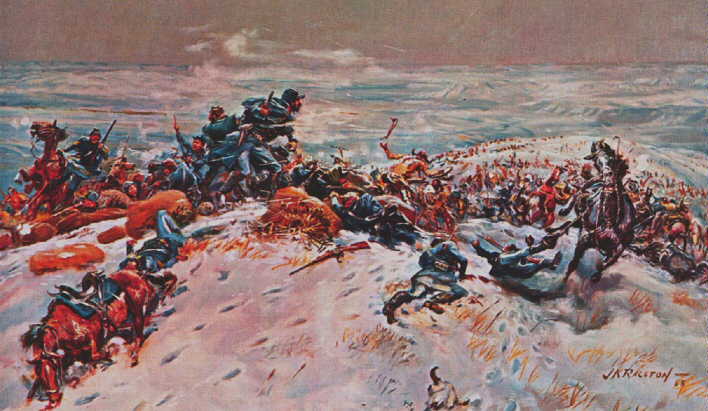 The Lakota ambushing of Fetterman |
The Great Sioux Wars | ||
| Today this site has a marker board next to what are now known as Crow Buttes on the west of US Highway 85. The site is about a mile south of Redig, Harding County which is in the far north west corner of South Dakota | 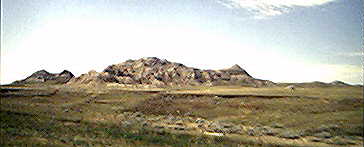 Crow Butte, Redig, South Dakota |
|
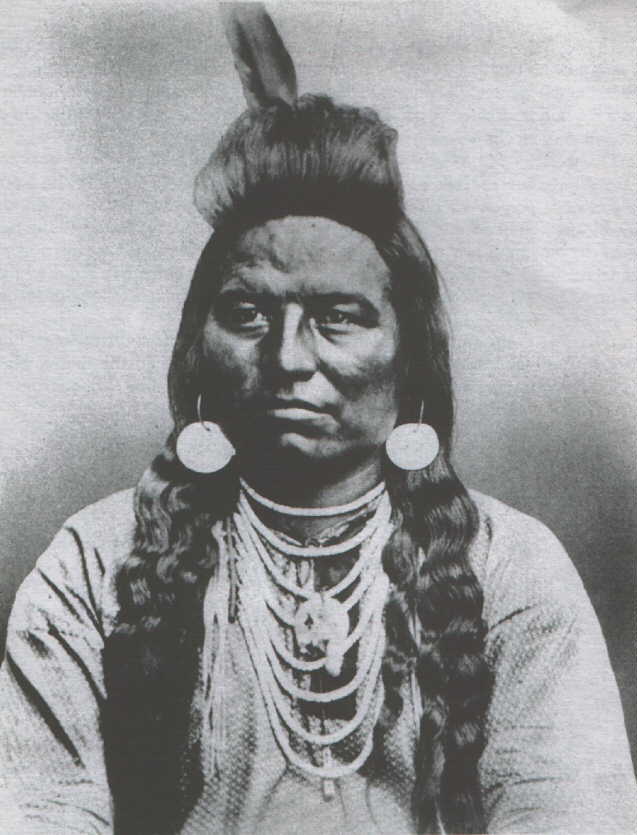 White Bear Naxpitse Chose Crow Absarokee | In 1849 a Crow raiding party, 25 stronge, led by White Bear, looted the Bordeaux Trading post and driven away 88 horses. James Bordeaux fled to Beaver Creek and told the Wazhazha Sihcangu(Brule) Lakota led by Two Strikes and Red Leaf were members of the Lakota war party who chased the Crow that day. The 200 Lakota warriors pursued the Crow. As the Crow reached a butte called Dancers Hill ten Crow charged the large Lakota enemy to let the horse herd have time to cross the White River. The Lakota then forced White Bear's Crow to take refuge on the butte. The Lakota decided to starve them out but the Crow danced and taunted the them. During this time Two Strikes tried to scale a steep side of the Butte, but the Crow dislodged boulder which rolled through his warriors, so they decided to withdrawal and camp at the base. After three days the Crow snuck out and all that was left was one dead Crow who had been injured earlier. This butte was renamed Crow Butte in memory of the battle. | 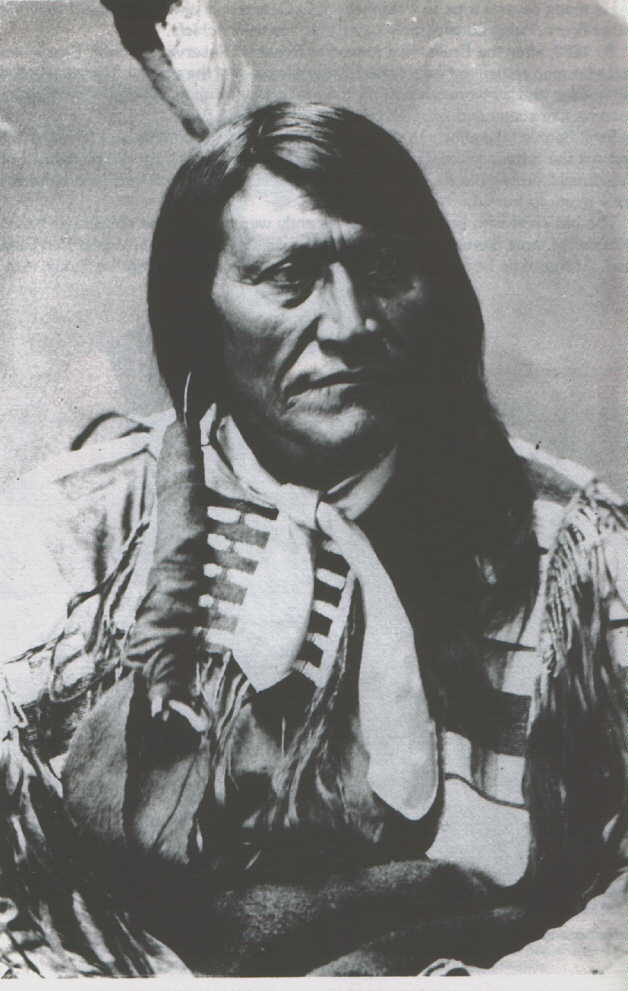 Two Strikes Nompa Apa Lakota |
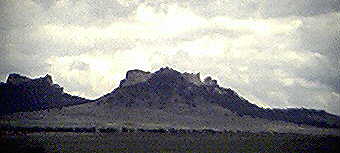 Crow Butte, Crawford | Crow Butte is 3 miles South East of the town of Crawford, Dawes County, Nebraska, just south of the South Dakota state border, and is in Plain view of US Highway 20. The marker is about 6.5 miles along this road, east in a layby south of the road. | |
| Trading posts and forts sprung up along the trail, most notably Fort Laramie. | ||
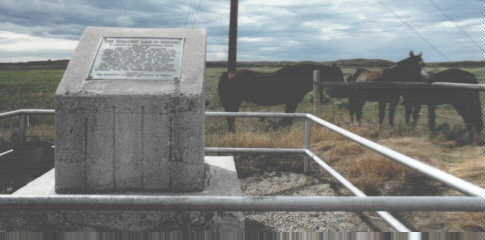 The monument to the ride from Fort Phil Kearney 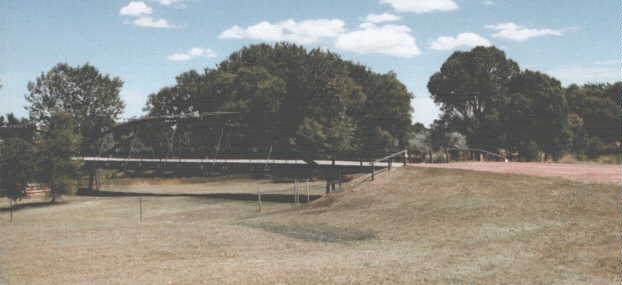 Laramie Bridge |
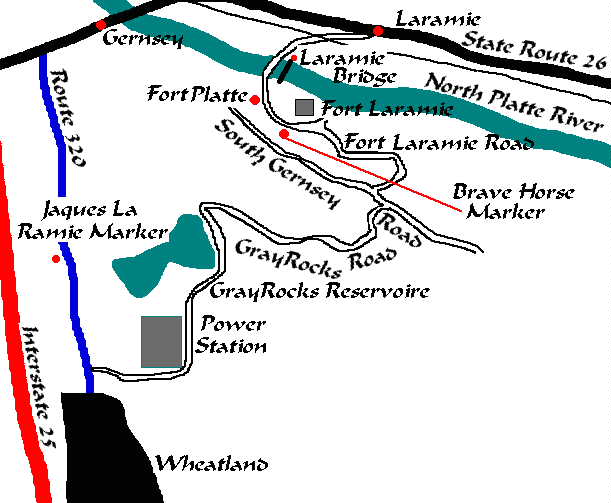 The Laramie Area This fort still exists and is being recreated, and stands on the North Platte River, in east Wyoming on road 160 off of State route 26. |
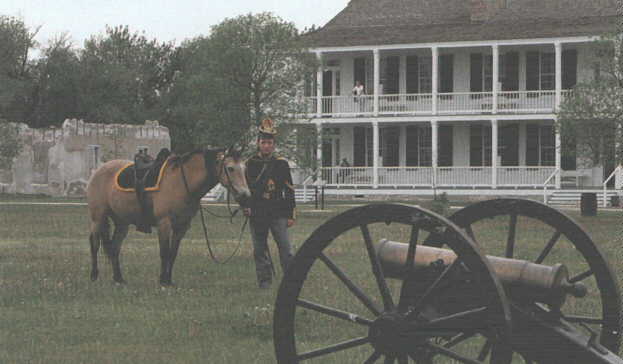 Fort Laranmie 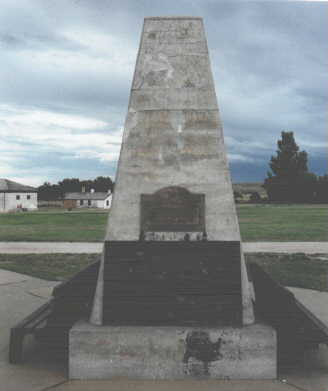 Fort Laramie and the Pony Express monument |
|
Because of the so-called Indian depredations along the trail, a treaty
was designed to give whites freedom and safe passage through this
country, as well as a number of other changes to Indian life. In
exchange the tribes would get annuities of food and other equipment
every summer.
The treaty was proposed by Thomas Fitzpatrick, known to the Indians
as Broken Hand, because he lost three fingers in a musket accident.
The Laramie Treaty as it was called was supposed to be signed at the
Fort, but because the gifts promised to the tribes were three weeks
away on 30th August 1851. A lack of food for the horses meant the
whole camp had to be moved 37 miles east to the mouth of Horse Creek. | ||
 |
Today there are three display boards, making the site, on State route
26 2.8 miles east of the town of Henry. The site itself is on private
land and you can't see much of the site because of the trees, but
if you go to Henry, and turn south on Nichol Avenue you can get a
closer look. On this road you will soon cross the North Platte river
and from there the land to your east is almost entirely the Horse
Creek treaty grounds. | 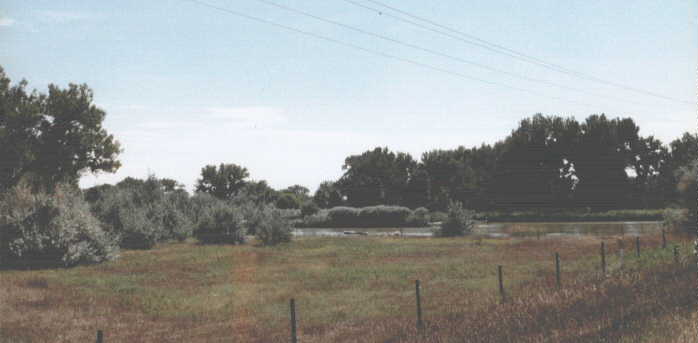 |
|
The Pawnees , Kiowas and Comanches stayed away, but the Sioux, Cheyennes,
enemies, the Crow, Atsina, and Assiniboins coming later. Never before
had so many enemies of the Sioux camped so close, without bloodshed.
The talks started with the demand from David D. Mitchell, the Superintendent
of Indian Affairs, that each Nation should have only one spokesman
to negotiate. This was unheard of among the tribes, and eventually
reluctantly the leaders of the Lakota Sioux chose Bear that scatters
his Enemies, or more commonly known as Conquering Bear, the Sicangu
or Brule leader. Once this was decided the talks resumed on 10th September, and they touched the pens to paper 17th September 1851.This was supposed to ensure that not only didn't the tribes fight each other, but they left the travellers on the overland trail alone. In the summer of 1854 the sun was hot, and the Brule of Conquering Bear settled a few miles down the North Platte River from Fort Laramie. Conquering Bear was told that the Government would give his people Food and other supplies if they didn't harass the settlers travelling through to Utah and California. His people had given their word and at this time the Indian Agent was due to arrive to hand over the food and supplies. The Agent was late, and the People were starting grow hungry. During this time settlers passed through, but a mormon boy in charge of a cow, lost control of it. This cow wandered straight into the Brule village, causing damage to tipis and meat racks. The boy was too frightened to chase to cow into the village, so a Miniconjou visitor to Conquering Bears village named High Forehead killed the animal, which was a poor old and boney. This was reported to Fort Laramie. The Mormons wanted their Cow back alive. This was impossible so Conquering Bear offered them a few of his best horses, but mormons were adamant. A few days later Fort Laramie sent a detachment of 32 soldiers and a drunken interpreter, under the command of Major Grattan. At the Brule Village Grattan demanded that High Forehead be handed over for trial. Conquering Bear couldn't do that because he was guest and tradition forbids it. The conversation was becoming heated so the people moved to the ravines at the edge of the village to watch. The drunken enterpreter was being abusive towards Conquering Bear. Conquerring Bear was shot and mortally wounded. This bought the warriors down on the 32 men. None were spared. After the warriors wanted to sack the now weakly defended Fort Laramie, but were talked out of this. Instead the bands headed north towards the Black Hills and Niobrara river. Conquerring Bear's people camped at the Mouth of the Snake River Where Conquerring Bear died. The Mouth of the Snake River is on private land
just north of the Merritt Reservoir. If you travel South from Valentine,
Cherry County, Nebraska, on State highway 97 until you come to the bridge
that crosses the Niobrara River, and stop in the lay by. Just look west, up
the river and where the high ground above this river and the Snake River
meet, that is the camp, and somewhere nearby in the sand hills the Young
Crazy had his vision. | ||
|
Crazy
Horse went on his first raiding party with the Brule in Nebraska against a
village Omahas. During this attack Crazy Horse killed his first person. It
was a woman, and for a woman to be killed by an enemy was a disgrace to the
warriors who allowed this to happened. Logan Fontelle one of their
chiefs was also killed.
This happened somewhere around today's Boone County, Nebraska. | ||
| As revenge for the Grattan defeat, General Harney was sent to the Lakota to attack and capture any Brule people he could. One stormy night in the summer of 1855when Young Crazy Horse went down the Little Thunder's village on Blue Creek to visit his mother's family. He found that the village had been destroyed and many people lie dead or dying. Many of the men had been captured including Crazy Horse's uncle, Spotted Tail. Crazy Horse rescued a Southern Cheyenne woman, who was visiting, whose son was dead. | ||
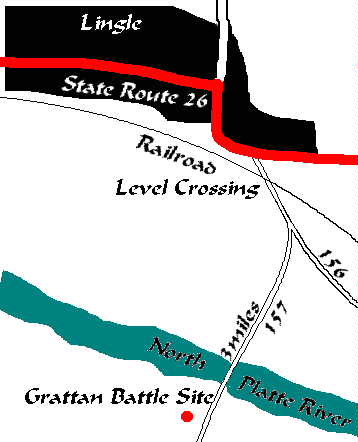 Conquerring Bear's Camp
| The Site of the Brule Village on that day is marked with a historic marker which comemerates the Grattan fight. It is situate in Wyoming 3 miles south of State route 26 to Nebraska. To get to the Site, go east through the town of Lingle, and on the final bend you will find route 156 which is on the right and crosses a Railroad level crossing. About 50 yards after the level crossing take the right fork for route 157. Exactly 3 miles along this road on the right stands the Marker. | 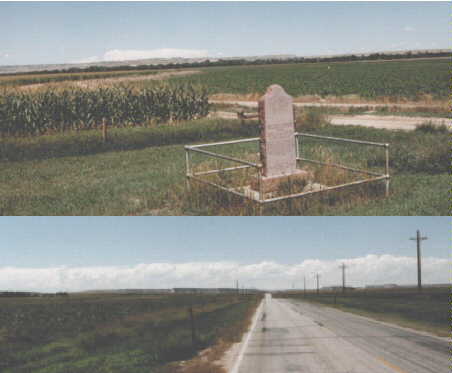 |
|
Crazy Horse's Vision At the age of thirteen, after Crazy Horse had witnessed the fatal wounding of Conquering Bear over the killing of the Mormon cow, and death of the 32 soldier under the charge of Grattan, his people moved north into the Sand Hill of Nebraska. His family stayed with Crazy Horse's step mother's family, who were Brule, and who had the mortally wounded Conquering Bear with them, came to rest at the mouth of the Snake River. Crazy Horse was known as Curly then and he knew that death was near. Curly saw this that morning, so in his confusion he went off on his own into hills to seek a vision. Some of the other boys tried to follow but he drove them back in his anger. He found a high place near where Roan Mule had an old eagle pit. He hobbled his horse, before lying bare to the beech cloth on gravel, with sharp stone between his toes, so he would stay awake. He stayed there for three days, his mind wondering to his pale appearance and untypical ways, but no vision came. In the end he went back to get his horse, but before he could, he suddenly felt faint and sat back against a tree, where went off into the land of shadows. He saw a naked warrior come out of the lake, with his hair hanging loose below the waist. He had a streak of lightning running from his forehead to his chin, he had hail spots painted on his chest and a round pebble hanging from one ear. The warrior carried no scalps and a red backed hawk flew overhead. He rode through a storm, and was unharmed, his own people tried to pull him down, but he rode through them, then the vision faded. The next thing Curly knew was his father and Hump, his adopted guardian, had found him and were angry with him because he left camp, when there was risk of attack from and enemy, for not going through the rituals in prepairing for a vision quest, as well as being too young. Not wishing to anger his father, said didn't tell him of vision, and said nothing until he came back from his first successful war party. He pretended that he had the vision during sweat lodge. When he told his father, the vision was then explained. As long as as he never took a scalp, he dressed like the warrior, he would be free from harm, but if he was held by one of his own he could hurt. Many of the things he did in his life back this up. Based on information from Mari Sandoz's - Crazy Horse: The Strange Man of the Oglalas
| 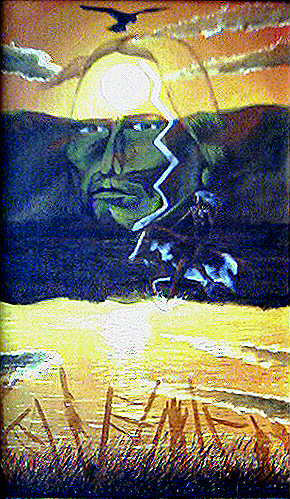 | |

| The Blue Water Massacre site is marked. If you travel east from Oshkosh on U.S. Highway 26 for about 10 miles you will see a Historic Marker on the left. A few hundred yards further you will cross Blue Creek. If you take the next unpaved road on the left after crossing the creek and drive along it, until you come to a bridge that re-crosses the Creek. From here look north towards the far bluffs. In the area between the creek and the bluffs was the camp. |
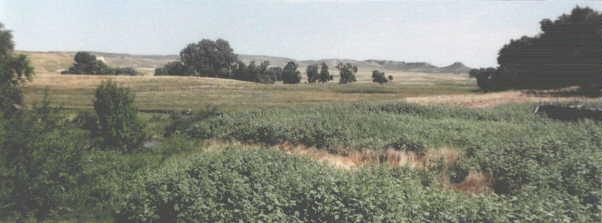 Blue Water Creek |
|
The Love of Crazy Horse's life This is a story that tells a totally different side of the great war chief Crazy Horse. It is the story of his love for his childhood sweetheart, Black Buffalo Woman. Black Buffalo Woman was the niece Chief Red Cloud. Crazy Horse was a small boy, called Curly, when she was born. He looked on her as being a member of his lodge, because his step mother stayed behind to help with her birth when the village was moving. He used to stop playing to chase away the flies that hung around her cradleboard, while her mother scraped hides. He would tickle the corners of her mouth with grass stems, until she awoke and laughed, learning to look out for young Curly. She had been one of the little girls in the ceremony when he received the name His Horse Looking, a name which nobody used. He was still Curly to everyone. |
 A rare picture of who I believe is Crazy Horse From the Book "To Kill an Eagle" by Edward & Mabell Kadlecek Johnson Books' 1881 publication | |
|
Then he used to throw plums at her, which his brother and sister teased
him about, but he still felt warmed by it. As he grew older he was
away from camp a lot of the time, but when their camps were together,
he would walk with her a long the water paths, until the old woman
of her lodge chased him away with loud shouting and abuse. He would
only run pretending to fear her and laughing. Black Buffalo Woman even
seemed to search him out during the day light circle, even during her
ceremony of Womanhood, but as Curly didn't show off in fine clothes, when
it was time of the young men to show themselves off to her, he left. In mid winter of 1861, Curly having been brave in Battle against the Omaha, had his new name Crazy Horse Tasunka Witko. later Red Cloud Mahpiya Luta decided to lead a large party against the Crow. When the Party was ready to go, one of Crazy Horse's arrivals for Black Buffalo Woman from Red Cloud's village, announced that he had tooth ache. The warrior was named No Water, and his medicine came from his teeth, so it would be dangerous going into battle with tooth ache, so he turned back. Crazy Horse went on with the party, and two weeks later, when he returned. Woman's Dress, a cousin of Black Buffalo Woman told Crazy Horse that she had married No Water. Crazy Horse took this news badly and could have killed Woman's Dress for bringing it, he slipped away through the willows to his lodge, not talking to anyone along the way, not even his mentor, Hump. In the family lodge he just buried his face in his sleeping robes, and none was allowed to come near him with food or with questions. His mother and the old woman of the lodge took their moccasin-making to a relative, and Worm, his father, went too, crossing a few pieces of brush before the lodge door to show that none was at home there. It was thought that Red Cloud was also involved in the treachery, so he would bring more power to his family, by marrying his niece to an up and coming young warrior in his own village. Now Young Crazy Horse lay in his blankets with tears, a stranger to his eyes, running over his lean brown cheeks. It was unusual to leave a son alone in the lodge in this manner. Packing bullets and powder Crazy Horse went North once more, going against the Crow. Nobody heard what he had done, but he had another gun which he gave to Little Hawk, his younger brother, a pair of far seeing glasses that the soldier chiefs carried and he threw two scalps to the dogs. After, he went to the hills with the robes for a sweat lodge, and when he came back he slipped into his old place in the village and none seemed to see anything different in him. But No Water kept himself and Black Buffalo Woman out of his way. Then one evening, coming home from a hunt, Crazy Horse found Black Buffalo Woman out alone gathering herbs and the strong smelling silver Sage plant. Seeing him coming she threw her blanket over her face, but when the horse had stopped beside her and no angry words or contempt were made she dropped the blanket. She said she had a duty to her father and brothers. Crazy Horse said he would have everything good between them. There could be no anger in his heart, even against himself. Having said this he rode off. Suddenly she threw everything from her blanket as far as she could, the fragrant plant too, and went home to tell No Water she must have new things from the traders-silver rings for her arms and blue cloth for a dress and many, many elk teeth for its decoration; these things she must have right away. Crazy Horse continued to feel badly about No Water getting Black Buffalo Woman and seldom went to Red Clouds village now. At the sun dance Based on information from Mari Sandoz's - Crazy Horse: The Strange Man of the Oglalas In the 1860s a trail was pushed through the middle of the Lakota, Northern Cheyenne, Arapaho, and Crow hunting grounds, to take advantage of the gold found in Montana, which would be known as the Bozeman Trail. After distruction of the Buffalo herds on the overland California Trail, the Northern Nations were not willing to let the whites do the same in the Powder River Country. Red Cloud unified the Lakota, Cheyenne and Arapaho, but couldn't make a treaty with their traditional enemy, the Crow. Forts were built along the trail, first was Fort Fetterman, then Fort Phil Kearney, and finally Fort C.F.Smith. The American government tried to make a new Treaty with the Nations but the bands with Red Cloud refused. In 1865 A war party with Crazy Horse attacked the Horse Shoe stage station, and destroyed it. | ||
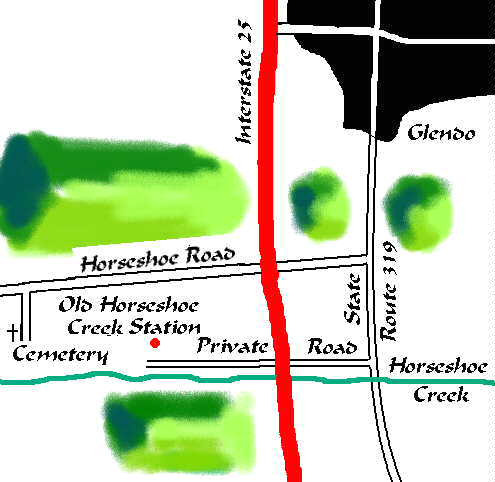 | This site is just off the highway
and just south of Glendo. The station was situated next to a butte,
shaped like a soldier's tent, which is just west of the highway. | 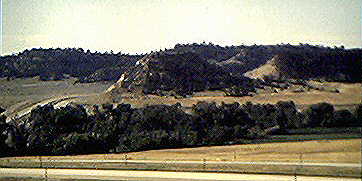 Horse Shoe Creek |
|
Julesburg 7-1-1865
The Town of Julesburg was routed twice in the 1860's by the Cheyenne, and Crazy Horse was with them during these battles. Julesburg
is about 100km south east of Scott's Bluff, Nebraska, in the north east cover of Colorado.
Platte Bridge 25-7-65
In 1865 Captain Connor was sent into the Powder River Country to bring the Nations under control. It was an expensve campaign
and the soldier were close to starvation, and the winter was killing their horses, but they did eventually find a village of
Arapaho on the Tongue River which his command was able to take. | 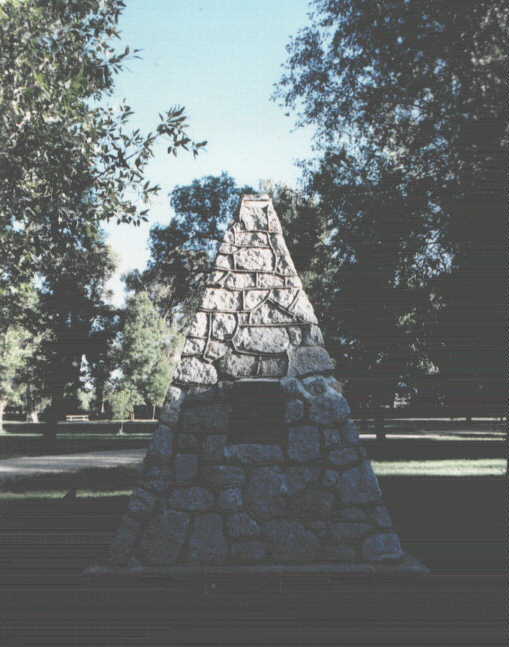 The Connor Battle Monument |
At Ranchester the site of the Connor fight is commemorated on the Ranchester Campsite |
|
Horse Shoe Creek, Glendo
In 1866 a war party with Crazy Horse attacked whites at Crazy Woman Creek between Kearney and Fetterman. If you leave the US Highway 25 about 5miles south of Buffalo, and get on the road heading south east which runs almost parallel to US25. About 8 miles down this road you will pass along side the Crazy Woman Creek fight south of the creek and on the land to the East of the road. Just north and west of the creek is a marker commemorating the Bozeman trail. The Monument is on private land but it is accessible, but please remember that it is private land, so be reverent and if you are asked to leave, which is unlikely, do so politely, but money does talk in the USA. At about this time a holy man had a vision that 100 soldiers would be rubbed out,and in 1867 Red Cloud devised an ambush at Fort Phil Kearney. Crazy Horse, and his good friend Lone Bear, and a few of Red Cloud's band were chosen to harass the fort's wood cutters, which they had been doing all Winter. As Red Cloud had planned a dettachment of soldiers were sent out to protect the Wood cutter. They were lead by Captain William J. Fetterman, who with 80 men claimed he could ride through the entire Sioux Nation. When Fetterman's detachment disappearing from view of the fort behind the high pine covered hills, Crazy Horse's band of decoys drew the 81 soldiers out onto a bluff, which was surrounded by the forces of Cheyenne, Arapaho and Lakota ammassed by Red Cloud. Fetterman and all his men were killed. Fort Phil Kearney is at the same turn off from the US Highway 25 as the towns of Story, and Banner. The fort is signpost, and it is set out with a museum. The Wagon Box fight is also nearby as is the site of the Fetterman ambush. Wagon Box Fight In 1873 Custer was part of the Stanley Expedition along the Yellowstone River. They were discovered at the mouth of the Big Horn River which is a tributary of the Yellowstone. Among the Lakota were Warriors like Crazy Horse and Sitting Bull, and a large number Cheyenne from the village of Black Kettle. On 27th November 1868 at peace camped under an American flag and a flag of truce was attacked by Custer at Washita Creek, Oklahoma. Most women children and the old were killed and the village and Pony herd distroyed before Cheyenne and Arapaho warriors drove Custer out. Black Kettle and his wife were killed. Sand Creek all over again. The Cheyenne warriors with the Lakota at the Yellowstone recognised Custer, and in their fury, spoilt an ambush arranged by Sitting Bull. They were on opposite side of the river and the shooting was at long range, but Sitting Bull to prove his stronge medicine sat with two other warriors in front of the battle line and smoked their pipes. Sitting Bull's strong medicine protected him and he was totally unscathed at the end of the fight. During the night Custer withdrew. At this time Crazy Horse's daughter "They are afraid of her" died. Two Moons and He Dog decided to go into the Agency while they still could. He Dog was one of Crazy Horses best friends, and felt very let down, with the big troubles ahead. Crazy Horse let them go. On 17th March 1876 He Dogs village was attacked in Dawn raid by Colonel Reynolds. His command was led by the Scout Frank "the Grabber"Grouard. The site is marked, and there is some maps of the site at the Folk Museum, in Broadus. The site is 30miles south of Broadus, Montana, along a gravel road. Tongue Heights-1876 Sitting Bull's Sun Dance Rosebud 17-6-1876 General Crook came up against Crazy Horse, and the Lakota and Cheyenne camped further along the RoseBud Creek in Montana. Travel along route. The Greasy Grass-Little Big Horn 25-6-1876 Yellow Hand The Northern Cheyenne leader,Yellow Hand was camped near War Bonnet Creek which is about half way between the Sacred Black Hills and the Lakota Indian Agency at Fort Robinson. The battle was called the first scalp for Custer. William "Buffalo Bill" Cody was scouting for the army, and he is said to have killed Yellow Hand himself. To find the site and marker for the battle called, "the Battle of War Bonnet Creek,travel along road. The site is along dirt track off this road near the tidy church of Montrose. Slim Buttes September 1876 After the death of Custer, the Lakota, and Cheyenne were hunted remorselessly. Under the charge of Captain Reynolds and being scouted for by "The Grabber", the Brule village of American Horse was discovered.American Hose and few of his followers got cut off in a small gulch. The soldiers concentrated much of there fire into the gulch, and eventually American Horse was fatally wounded in the Stomach. You will find the Site and marker for The battle of Slim Buttes if you travel between Lemmon and Harding, South Dakota. Wolf Mountains January 1877 After Crazy Horse had reached Fort Robinson and given up fighting in May 1877, he got word that Lame Deer had been killed in an attack by the fourth Cavalry under Captain Miles "Bear Coat" Nelson in a dawn attack on the Mniconjou village camped on Muddy Creek, near Rosebud Creek, Montana. 13 other warriors died including Iron Star, and Bear Coat lost four soliers. Lame Deer is on the Northern Cheyenne Reservation, and the site is 1.33miles south west of the town of Lame Deer on US Highway 212. Dull Knife Fort Robinson 9-1877 Sitting Bull's arrest 1890 Wounded Knee 1890
 Camp on the Cheyenne River Reservation at the Timber Valley Ranch You want to just say Hi!, Or have a problem, Mail Me!  |
Top Native American Books
    
|